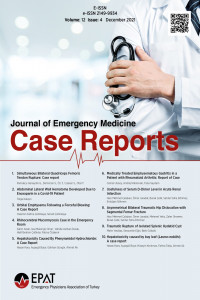Öz
Kaynakça
- 1. Goodman ZD. Phenotypes and Pathology of Drug-Induced Liver Disease. Clin Liver Dis 2017; 21(1): 89–101. doi: 10.1016/j.cld.2016.08.006. PMID: 27842777.
- 2. European Association for the Study of the Liver. EASL Clinical Practice Guidelines: Drug-induced liver injury. J Hepatol 2019; 70(6): 1222–61. doi: 10.1016/j.jhep.2019.02.014. PMID: 30926241.
- 3. Ergün H, Polat O, Demirkan NA, Günalp M, Gürler S. The efficacy, safety, and pharmacokinetics of intramuscular and oral phenyramidol in patients with low back pain in an emergency department. Turk J Med Sci 2010; 40(1): 71–6.
- 4. Köksal AS, Köklü S, Filik L, Sasmaz N, Sahin B. Phenyramidol-associated liver toxicity. Ann Pharmacother 2003; 37(9): 1244–6. doi: 10.1345/aph.1D035. PMID: 12921508.
- 5. Orak Y, Barçin T, Orak F. Increase of Liver Enzyme Caused by Suicidal Overdose of Phenyramidol Hydrochloride. Journal of the Turkish Society of Intensive Care 2013; 11(2): 80–2.
- 6. Pandit A, Sachdeva T, Bafna P. Drug-Induced Hepatotoxicity: A Review. Journal of Applied Pharmaceutical Science 2012; 2: 233–43. doi: 10.7324/JAPS.2012.2541.
- 7. Zárybnický T, Boušová I, Ambrož M, Skálová L. Hepatotoxicity of monoterpenes and sesquiterpenes. Arch Toxicol 2018; 92(1): 1–13. doi: 10.1007/s00204-017-2062-2. PMID: 28905185.
- 8. Devarbhavi H. An Update on Drug-induced Liver Injury. J Clin Exp Hepatol. 2012;2(3):247–59. doi: 10.1016/j.jceh.2012.05.002. PMID: 25755441; PMCID: PMC3940315.
- 9. Verma S, Kaplowitz N. Diagnosis, management and prevention of drug-induced liver injury. Gut 2009; 58(11): 1555–64. doi: 10.1136/gut.2008.163675. PMID: 19834119.
- 10. Shu CC, Lee CH, Lee MC, Wang JY, Yu CJ, Lee LN. Hepatotoxicity due to first-line anti-tuberculosis drugs: a five-year experience in a Taiwan medical centre. Int J Tuberc Lung Dis 2013; 17(7): 934–9. doi: 10.5588/ijtld.12.0782. PMID: 23743313.
Öz
Introduction: Drug-induced liver injury is a common cause of liver dysfunction. Phenyramidol causes a neuronal blocking effect and is used as a moderately potent non-narcotic analgesic that can be accompanied by muscle relaxant activity. In this article, a clinically asymptomatic case of hepatotoxicity is described following the intake of phenyramidol HCl tablets in a suicide attempt.
Case Report: A 52-year-old female patient was admitted to the emergency department 24 hours after allegedly attempting suicide by ingesting 16 tablets of 400 mg phenyramidol HCI. She displayed no clinical symptoms. An abdominal examination was normal. The results of her first blood test showed: ALT at 58 U/L and AST at 55 U/L. After 24 hours, ALT and AST were measured at 594 U/L and 820 U/L, respectively. The patient, whose liver function tests regressed following symptomatic treatment administered in the gastroenterology department, was discharged 5 days later.
Conclusion: Drug toxicities can be difficult to diagnose but becomes easier if an agent can be identified that is suspected of causing liver injury. Accordingly, phenyramidol should be considered as a drug that causes hepatotoxicity.
Anahtar Kelimeler
Kaynakça
- 1. Goodman ZD. Phenotypes and Pathology of Drug-Induced Liver Disease. Clin Liver Dis 2017; 21(1): 89–101. doi: 10.1016/j.cld.2016.08.006. PMID: 27842777.
- 2. European Association for the Study of the Liver. EASL Clinical Practice Guidelines: Drug-induced liver injury. J Hepatol 2019; 70(6): 1222–61. doi: 10.1016/j.jhep.2019.02.014. PMID: 30926241.
- 3. Ergün H, Polat O, Demirkan NA, Günalp M, Gürler S. The efficacy, safety, and pharmacokinetics of intramuscular and oral phenyramidol in patients with low back pain in an emergency department. Turk J Med Sci 2010; 40(1): 71–6.
- 4. Köksal AS, Köklü S, Filik L, Sasmaz N, Sahin B. Phenyramidol-associated liver toxicity. Ann Pharmacother 2003; 37(9): 1244–6. doi: 10.1345/aph.1D035. PMID: 12921508.
- 5. Orak Y, Barçin T, Orak F. Increase of Liver Enzyme Caused by Suicidal Overdose of Phenyramidol Hydrochloride. Journal of the Turkish Society of Intensive Care 2013; 11(2): 80–2.
- 6. Pandit A, Sachdeva T, Bafna P. Drug-Induced Hepatotoxicity: A Review. Journal of Applied Pharmaceutical Science 2012; 2: 233–43. doi: 10.7324/JAPS.2012.2541.
- 7. Zárybnický T, Boušová I, Ambrož M, Skálová L. Hepatotoxicity of monoterpenes and sesquiterpenes. Arch Toxicol 2018; 92(1): 1–13. doi: 10.1007/s00204-017-2062-2. PMID: 28905185.
- 8. Devarbhavi H. An Update on Drug-induced Liver Injury. J Clin Exp Hepatol. 2012;2(3):247–59. doi: 10.1016/j.jceh.2012.05.002. PMID: 25755441; PMCID: PMC3940315.
- 9. Verma S, Kaplowitz N. Diagnosis, management and prevention of drug-induced liver injury. Gut 2009; 58(11): 1555–64. doi: 10.1136/gut.2008.163675. PMID: 19834119.
- 10. Shu CC, Lee CH, Lee MC, Wang JY, Yu CJ, Lee LN. Hepatotoxicity due to first-line anti-tuberculosis drugs: a five-year experience in a Taiwan medical centre. Int J Tuberc Lung Dis 2013; 17(7): 934–9. doi: 10.5588/ijtld.12.0782. PMID: 23743313.
Ayrıntılar
| Birincil Dil | İngilizce |
|---|---|
| Konular | Klinik Tıp Bilimleri |
| Bölüm | Case Report |
| Yazarlar | |
| Yayımlanma Tarihi | 14 Aralık 2021 |
| Gönderilme Tarihi | 29 Mayıs 2021 |
| Yayımlandığı Sayı | Yıl 2021 Cilt: 12 Sayı: 4 |


